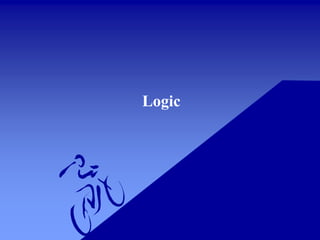
Lecture 1 introduction to logic
- 1. Logic
- 2. Logic Logic is the study of methods, principles, and techniques used to distinguish correct from bad reasoning.
- 3. Logic • Some apples are red. Therefore it follows that President Obama was actually born in the old Soviet Union, which makes him ineligible to be President of the United States.
- 4. Reasoning The process of using a rational, systematic series of steps based on sound procedures and given statements to arrive at a conclusion. A special kind of thinking in which problems are solved, in which inference takes place., that is, in which conclusions are drawn from premises.
- 5. Reasoning Inference /Conclusion Refers to the process by which one proposition is arrived at and affirmed on the basis of one or more other propositions accepted as the starting point of the process.
- 6. Propositions/Statement A claim/statement that either affirms or denies something or is either true or false. Although its truth or falsity may be unknown.
- 7. Preposition • For example – “There is life on some other planet in our galaxy”
- 8. Proposition • Do you know how to play chess? – Question assert nothing, therefore it is not proposition
- 9. Proposition • Proposition is the term we use to refer to what it is that declarative sentences are typically used to assert. • For Example – It is raining
- 10. Continued… Difference between sentence and proposition A sentence is always a sentence in a particular language, the language in which it is used. Propositions is not peculiar to a language. Exactly the same sentence, in different contexts, may be used to make different propositions. Example: – The present president of Pakistan is an army chief. General Zai-ul-Haq in 1980s General Pervez Musharraf in 2002
- 11. Proposition/Sentence • “The largest state in the United States was once an independent republic” – “once” expressed a true statement or proposition (about Texas) – but if asserted today would express a false statement or proposition (about Alaska) – The same words assert different propositions at different times.
- 12. Proposition • Compound Proposition – containing other propositions within themselves – For Example • The Amazon Basin produces roughly 20 percent of the Earth’s oxygen, creates much of its own rainfall, and harbors many unknown species. – In above sentence we have three Proposition » What it produce » What it create » What it harbors –
- 13. Proposition • Conjunctive Proposition – The conjunctive proposition is one which asserts that two alternatives cannot be true at the same time. (It is possible for both alternatives to be false.) – For Example • “Canada is in North America and New York City is the biggest city in Canada”. • From above example it is clear that, if either one of the individual propositions are False, then the whole thing is False. And since we know that one is False, indeed the whole thing is taken as False
- 14. Proposition • Disjunctive Proposition – It presents two or more alternatives, one of which is true. Its members are linked by the conjunctions “either…or” – For Example • "Canada is in North America or New York City is the biggest city in Canada.“ • Now we have one proposition that is True, so the whole thing is seen as True.
- 15. Proposition • Conditional Proposition – In this type of proposition one clause asserts something as true provided that the other clause is true • The first clause is “if” • The second one is “then” • For Example – If strong typhoons come, then crops will be destroyed
- 16. Argument • An argument is one or more statements, called premises, offered as a reason to believe that a further statement, called the conclusion, is true, that is, corresponds to reality. • To tell your audience that you are drawing your conclusion, introduce your statement using a word or phrase such as “therefore,” “in conclusion,” “thus,”
- 17. Argument • For Example – No one was present when life first appeared on earth. Therefore any statement about life’s origins should be considered as theory, not fact – Premise: No one was present when life first appeared on earth – Conclusion: Therefore any statement about life’s origins should be considered as theory, not fact.
- 18. Deductive Argument • A deductive argument is an argument in which it is thought that the premises provide a guarantee of the truth of the conclusion. • In a deductive argument, the premises are intended to provide support for the conclusion that is so strong that, if the premises are true, it would be impossible for the conclusion to be false. • in deductive argument we move from
- 19. Deductive Argument • You can tell your audience that your argument is deductive by introducing your conclusion with wording such as “therefore it must be that,” or “it necessarily follows that,” or “therefore it is certain that,” or “it is conclusively proven that,” and so on. These phrases are called “deductive indicators.”
- 20. Inductive Argument • An inductive argument is an argument in which it is thought that the premises provide reasons supporting the probable truth of the conclusion. • In an inductive argument, the premises are intended only to be so strong that, if they are true, then it is unlikely that the conclusion is false. • For Example – The members of the Williams family are
- 21. Inductive Argument • You tell your audience that your argument is inductive by introducing your conclusion with wording such as “therefore it is probably the case that,” or “it is likely that,” or “therefore it is reasonable to conclude that,” and so on. These phrases are called “inductive indicators.”
Notes de l'éditeur
- Premise a previous statement or proposition from which another is inferred or follows as a conclusion